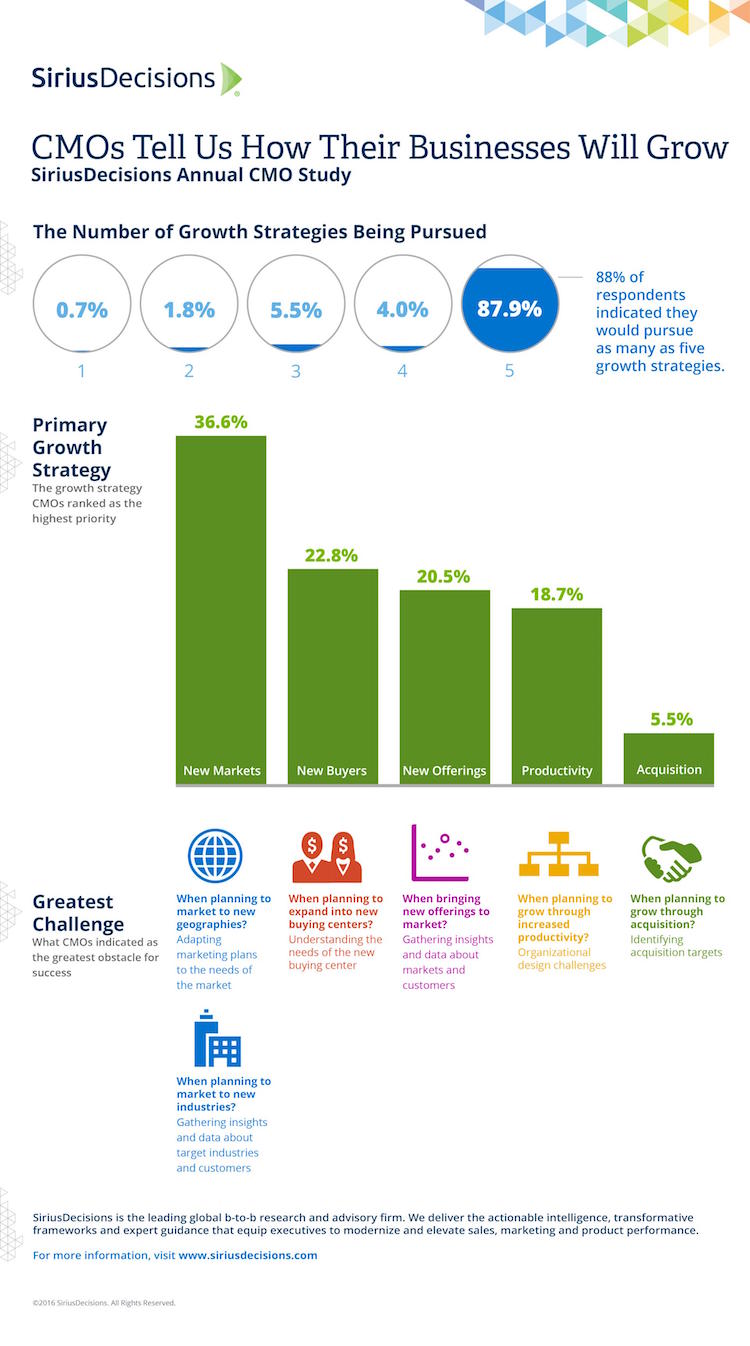CMOs Tell Us How Their Businesses Will Grow
- Eighty-eight percent of B2B companies are pursuing as many as five growth strategies
- Pursuing too many growth strategies can present significant challenges and result in a lack of focus
- Creating focus requires an assessment of the challenges and requirements associated with each growth strategy
If you joined us for the 2016 SiriusDecisions Summit you heard a number of references throughout the week to our Intelligent Growth Model. It illustrates the five pillars of growth that B2B companies can choose from or combine as their path to achieving their desired growth objectives:
- Markets. Expansion into new geographies, segments or industries.
- Buyers. Targeting of new buying centers or buyer personas.
- Offerings. Introduction of new offerings or enhancements to existing offerings.
- Acquisitions. Acquisition of another company or the incubation of new business units.
- Productivity. Growth through maximizing efficiencies, effectiveness and engagement.
We believe it makes sense for B2B companies to take a measured, intelligent approach to these five core levers of growth, because each has unique implications for product, marketing and sales to execute effectively against the growth strategy.
Equally important is the alignment and consistent focus of product, marketing and sales on the growth strategy. We continually emphasize this point, because our studies have indicated that companies that maintain this focus achieve up to 19 percent faster revenue growth and 15 percent higher profitability than other companies.
It might surprise you to see what marketing leaders told us about their company’s growth strategy in our 2016 annual CMO study. We asked more than 270 global marketing leaders to rank the Intelligent Growth® pillars by importance to their company over the next two years, choosing only those that apply.

An astounding 88 percent indicated that their company would pursue as many as five growth strategies. While it’s feasible for some companies to be pursuing all five strategies, that probably isn’t what’s driving this response. These results more likely reveal that most companies aren’t taking an intelligent, measured approach to defining their growth strategies, leading to one of the top struggles marketing leaders face today: establishing and maintaining focus.
The infographic also illustrates marketing leaders’ prioritization of growth strategies, along with what respondents told us was their greatest challenge. However, the greatest challenge isn’t the only one – each growth strategy comes with its own set of unique challenges and requirements that companies must address if they want to attain the corporate goals within each pillar.
In some companies, product, marketing and sales leaders may play a role in defining the corporate growth strategy. In others, the growth strategy may be a high-level mandate that everyone just needs to accept. In either scenario, creating focus requires the following:
- A unified growth strategy. Ensure product, marketing and sales are aligned on the prioritization of the growth strategies.
- The right competencies. Just because there’s a defined path for growth doesn’t mean the necessary knowledge, skills and tools exist to execute effectively against the growth strategy. Product, marketing and sales leaders must identify the necessary requirements for execution and assess them against the current state. Don’t assume your teams are ready to rush to execution.
- Synchronized execution. If product, marketing and sales aren’t executing against a set of prioritized actions, they might all be working hard to achieve the same goal, but in a suboptimal way.
Addressing these criteria requires an approach that should be embedded into the overall planning process. In my next blog post, I’ll share an approach for assessing organizational and functional readiness to execute against the growth strategy that will enhance the overall planning process, driving greater alignment across functions and optimizing performance. In the meantime, assess the current state of your company’s growth strategy. Are you part of the 88 percent that’s trying to do it all?
